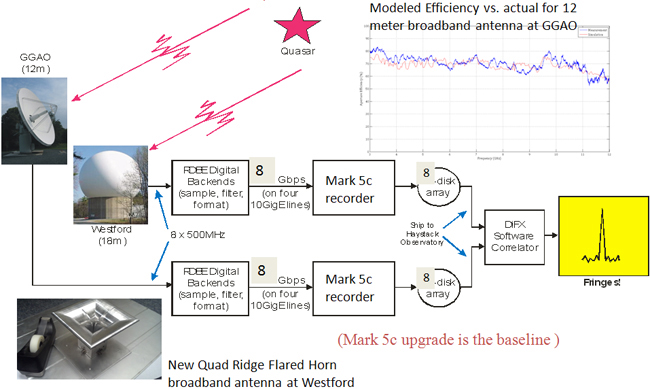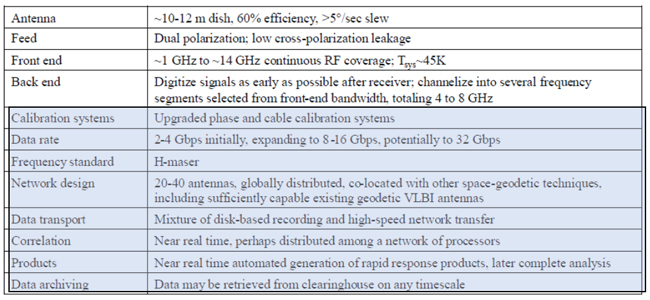VLBI2010 Demonstration with Full Configuration at GGAO
Major progress was demonstrated on the VLBI portion of the SGP project. In the upper right of Figure 1, a comparison (made by Haystack Observatory)is shown of modeled efficiency for the Quad Ridge Flared Horn (QRFH) developed by California Institute of Technology (ref. http://www.ursi.org/proceedings/procGA11/ursi/J03-10.pdf ), and actual experimental results from 2011 tests between stations at Westford MA and Greenbelt MD (GGAO). The comparison showed that the aperture efficiency of the QRFH feed with the 12 meter reflector performed as expected and met the 60% aperture efficiency characteristic of the SGP element over most of the bandwidth.

Figure 1.
In the lower left of Figure 1, another QRFH feed (at Westford), tailored to work with the existing VLBI reflector and a new cryogenic front end, arrived for integration on the next round of tests. Like its GGAO predecessor, the Westford front end is designed to meet the next generation broadband sensitivity characteristic of "~1 GHz to ~14 GHz continuous RF coverage; Tsys~45K" (see Figure 2 for a list of key characteristics). Tailored to the station radio frequency interference (RFI) environments, both front ends will need high-pass filtering at the low end (1-3 GHz) to adapt to the local environment.
As shown in the block diagram portion of Figure 1, back-end hardware and firmware components were in the baseline configuration at both stations. Data collection goals were met with the baseline configuration. Specifically, the back-end characteristic, "Digitize signals as early as possible after receiver; channelize into several frequency segments selected from front-end bandwidth, totaling 4 to 8 GHz", was realized in the January test.
 Figure 2.Key characteristics of next-generation VLBI system. (ref. VLBI2010: Current and Future Requirements for Geodetic VLBI Systems)
Figure 2.Key characteristics of next-generation VLBI system. (ref. VLBI2010: Current and Future Requirements for Geodetic VLBI Systems)

